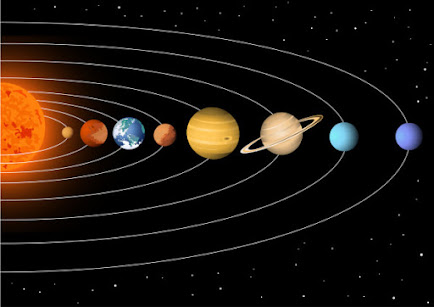GALAXY FACTS
Galaxies are groups of billions of stars that are held together by the force of gravity . Most galaxies are either spiral or elliptical , but some are irregular in shape .
THE MILKY WAY
The best known galaxy is the milky way . The word galaxy itself comes from the Greek word for milk . This is because before telescope were powerful enough to prove that they were made up of individual stars , galaxies looked like milky or cloudy areas in the sky . Our relatively small solar system is only one of 100-200 billion stars in the milky way galaxy . Which is 100,000 light years in diameter . The sun and all the planets take about 200,000,000 years to complete one orbit around its center .
BRIGHTEST GALAXY
The large magellanic cloud . which is visible only in the southern hemispere , is 170,000 light years from earth and 39,000 light years in diameter .
LARGEST GALAXY
The central galaxy of the abell 2029 galaxy cluster was discovered in 1990 . It is 1070 million light years distant and has a diameter of 5.6 million light years , 80 times the diameter of our own galaxy . It has a total light output equivalent to 2 trillion times that of the sun .
NEAREST GALAXY
The sagittarius Dwarf , discovered in 1994 , is more than 70,000 light years from earth and is being torn apart .
REMOTEST VISIBLE OBJECT
The most distant thing in the universe that can be seen with the naked eye is the andromeda galaxy , which is 2,309,000 light years from earth . This galaxy has 300 billion stars and a diameter of 180,000 light years . The light we see now from andromeda left there just after the first humans appeared on earth .
MOST DISTANT GALAXY
In 2004 , astronomers at the european southern observatory , chile announsed the discovery of galaxy Abell 135 IR 1916 . It exists an astonishing 13.2 billion light years from earth .
CONSTELLATIONS
Groups of stars form patterns in the night sky , which are called constellations . There are 88 known constellations . The sumerians a middle eastern civilizations , probably named them about 5,000 years ago . They called them after the shapes , objects or animals that they thought they looked like or after mythological characters .
The largest is hydra , the sea serpent and the smallest is crux australis , the southern cross . Centaurus the centaur has the most stars that can be seen with the naked eye . Others include Aquila the Eagle , Draco , the Dragon , Canis , Major , the Great dog and Orion the Hunter .
SOLAR SYSTEM
The solar system was formed about 4,560 million years ago . It is made up of the nine planets - Mercury , Venus , Earth , Mars , Jupiter , Saturn , Uranus , Neptune and Pluto , as well as their moons , comets and other bodies . These all orbit around our Sun to which they are attracted by gravity . Lets see the planets one by one .
1. MERCURY
Diameter : 4,880 km
Mass : 3,302,000,000,000 tonnes
Average distance from sun : 57,909,175 km
Rotation : 58.6462 days
Avg temperature : + 166.86`c
Moons : 0
Mercury was named after the speedy messenger of the god because it seemed to move more quickly than the other known planets . In 2004 NASA launched MESSENGER probe , which is due to reach Mercury in 2011 .
2. VENUS
Diameter : 12,103.6 km
Mass : 48,690,000,000,000 tonnes
Avg distance from sun : 108,208,903 km
Rotation : 243.0187 days
Orbit : 224.701 days
Avg temperature : +456.85`c
Moons : 0
In size , mass , density and volume Venus is the planet most similar to Earth . Venus rotates backwards , from east to west , so the Sun would appear to rise in the east and set in the west . In april 2006 the European Space Agency Venus express spacecraft reached Venus .
3. EARTH
Diameter : 12,756.3 km
Mass : 59,720,000,000,000 tonnes
Avg distance from sun : 149,600,000 km
Rotation : 0.99727 days
Orbit : 365.256 days
Avg temperature : +15`c
Moons : 1
Earth is a watery planet 70 % of its surface appears blue and the only one that can support life . From space astronauts have observed cities , forest fires , roads , airports , dams and other large structures such as the Great Pyramid and the Great wall of China .
4. MARS
Diameter : 6,794 km
Mass : 6,421,900,000,000 tonnes
Avg distance from sun : 227,940,000 km
Rotation : 1.025957 days
Orbit : 686.98 days
Avg temperature : -63`c
Moons : 2
Several space probes have flown past or landed on Mars , providing information on its atmosphere and features , such as the volcano Olympus Mons . This stands 27 km high more than three times the height of Mount Everest . The latest craft to visit the red planet is Mars Reconnaissance Orbiter , which began a four year orbit in 2006 .
5. JUPITER
Diameter : 142,984 km
Mass : 18,986,000,000,000,000 tonnes
Avg distance from sun : 778,412,010 km
Rotation : 9 hours 53 minutes
Orbit : 11 years 314 days
Avg temperature : +14.85`c to +19.85`c
Moons : 63
Jupiter is the largest planet in the solar System and is big enough to contain more than a thousand Earths . Four of its many moons were among the first ever astronomical discoveries made with a telescope , by Galileo in 1610 . More were identified by later astronomers and in 1979 by the space probe Voyager2.
6.SATURN
Diameter : 120,536 km
Mass : 5,684,600,000,000,000 tonnes
Avg distance from sun : 1,426,725,400 km
Rotation : 10 hours 34 minutes
Orbit : 29 years 168 days
Avg temperature : -139.5`c
Moons : 34
Saturn is the second largest planet but the least dense . Its distinctive rings are made of pieces of ice and rock which were probably parts of comets and asteroids . These rings are being examined by the joint NASA/European Space Agency project Cassini/Huygens . Launched in 1997 , cassini began a four year orbit of the ringed planet in july 2004 .
7.URANUS
Diameter : 51,118 km
Mass : 868,320,000,000,000 tonnes
Avg distance from sun : 2,870,972,200 km
Rotation : 17 hours 17 minutes
Orbit : 84 years 4 days
Avg temperature : -197.15`c
Moons : 27
All the named satellites of Uranus are called after characters from either William Shakespeare's plays or Alexander Pope's poem " The Rape of the Lock " . Some have only recently been discovered and as yet do not have names . Uranus has rings like those of Saturn , but they are visible only with a powerful telescope .
8.NEPTUNE
Diameter : 49,522 km
Mass : 1,024,700,000,000,000 tonnes
Avg distance from sun : 4,498,252,900 km
Rotation : 16 hours 7 minutes
Orbit : 164 years 298 days
Avg temperature : -200.15`c
Moons : 13
The orbits of Neptune and Pluto cross each other . Neptune is the furthest of the nine planets currently , and for 20 years of every 248 . Surface winds are the strongest of any planet at up to 2,000 km/hr . Neptune's year is so long that it has not completed an orbit round the Sun since its discovery and will not until 2011 .
9.PLUTO
Diameter : 2,390 km
Mass : 129,000,000,000 tonnes
Avg distance from sun : 5,913,520,000 km
Rotation : 6 days 9 hours 18 minutes
Orbit : 247 years 256 days
Avg temperature : -215.35`c
Moons : 3 ( Charon and two unnamed , discovered in 2005 )
Though discovered by an American , Pluto's name was suggested by an 11 year old British school girl , Venetia Burney .
SUN FACTS
The sun is 149,597,893km from Earth and has a diameter of 1,391,940 km . This is more than 100 times larger than Earth . Its mass is equivalant to 99.98 per cent of the mass of the entire Solar System .
Elements
The sun is mostly made up of two light gases , 75 per cent hydrogen and 23 per cent helium , with relatively small quantities of other elements , including metals such as gold . Helium was discovered in the Sun before it was detected on Earth . Its name comes from helios , the Greek word for sun .
Temperature
The sun has a surface temperature of 5,880k but it can be 56,000,000k at its core . ( k represents kelvin , which is an astronomical temperature , it can be converted to Celsius by substracting 273.16. ) at the Sun's center , nuclear fusion constantly changes hydrogen into helium and the energy and heat released from this process rise to the surface . The yellow surface we see is called the photosphere .
The corona
The outermost layer of the Sun extends millions of kilometers into space but is visible only during eclipses . At a height of 75,000km in the corona , the temperature may reach 2,000,000k .
Rotation
The Sun rotates once every 25.4 days , but because it is not solid like a planet or moon , the poles spin at diffrent rate , taking as much as 36 days to complete a single revolution .
Solar eclipses
When the moon lies between the Earth and the Sun , its blocks out the light causing either a partial or total eclipse . At this time astronomers are able to observe the corona in detail .
MOON FACTS
Earth's Moon is the most familiar and also the largest satellite in relation to its planet in the entire Solar System . It is the first body in the Solar System on which vehicles from Earth landed , and the only one to be explored by humans .
Diameter : 3,475.6 km
Distance from Earth : 406,711km ( furthest , 1912 )
to 356,375km ( closest , 1984 ),
384,403km ( average )
Mass : 734,556,000,000 tonnes
Rotation : 27 days 7 hours 43 minutes 11.5 seconds
Surface temperature : -163`c to +117`c
......................................................................................................................................................................















0 Comments
thanks for u r feedback